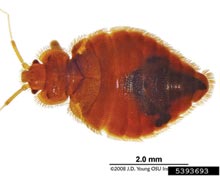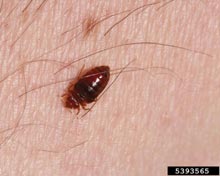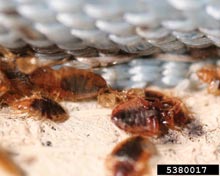
James Young, Oregon State University

Whitney Crenshaw, Colorado State University

Gary Alpert, Harvard University
Bed Bug
General Description
The bed bug is wingless, only about one-fourth of an inch long, and flat to fit in cracks and crevices where they hide by day. At night, bed bugs seek warm bodies, leaving their hiding places in mattresses, box springs, bed frames, nightstands, curtains, couches, wall voids, behind baseboards, carpet edges, door/window frames, picture frames, peeling paint and wallpaper. The bug’s beak-like mouth parts painlessly pierce its victim, inject saliva and suck up the host’s blood. During the three to five minutes it takes to complete feeding, the bug elongates and becomes reddish brown. It then retreats to its hiding place for a few days to digest the meal. Reactions to bed bug bites vary among individuals. Those who are bitten usually don’t realize it until the body reacts with inflammation and swelling around the bite, along with intense itching. While pathogens have been isolated from bed bugs, they apparently do not transmit diseases to humans.
General Control
When bed bugs are suspected, a thorough inspection should commence in areas where people sleep or rest.
Check all possible hiding places, mindful that bed bugs can fit into any tiny crack or crevice. Once bed bug hideouts
are discovered, a non-toxic solution is to simply vacuum them and dispose of the bag in a sealed garbage
bag or trash container. However, vacuuming alone probably will not eliminate all bed bugs from the premises,
but can supplement pesticide treatments. Pesticides labeled for bed bugs can be applied directly into cracks and
crevices harboring bed bugs. Space treatments (“fogging” and “bug bombs”) are ineffective against well-hidden
Bed Bugs. Heat treatments can be effective, but provide no residual effect. Bed bug infestations can be very
difficult to treat and usually require a professional pest control service with experience in bed bug control, as well
as the cooperation of residents and building management to prepare rooms for treatment, and to promptly report
bed bug activity.









